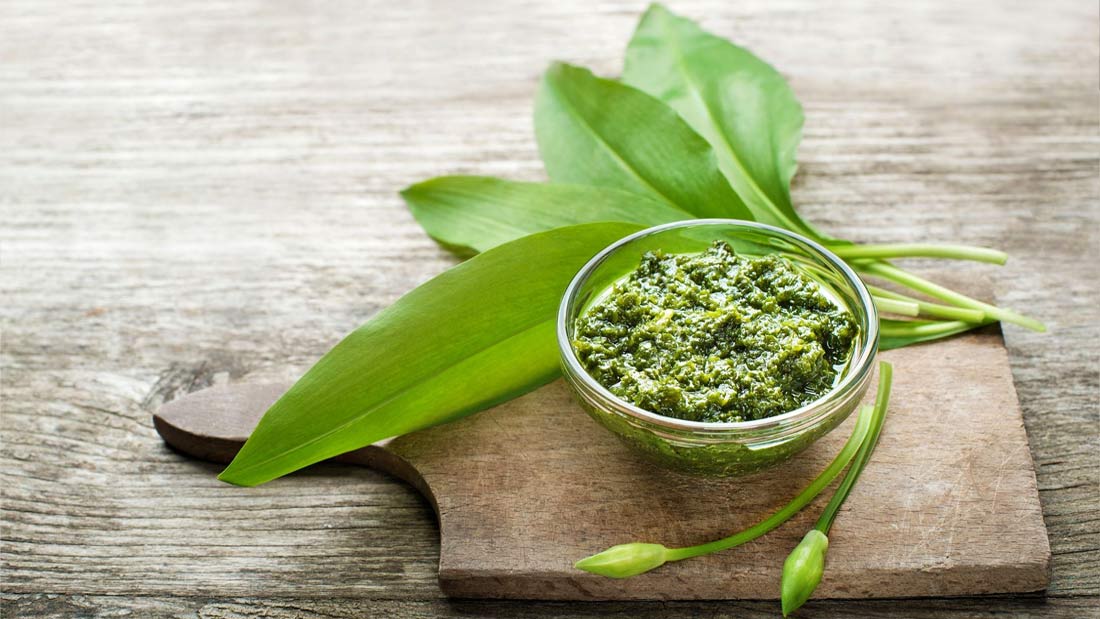Wild Garlic

Wild garlic’s dark green leaves carpeting spring woods look beautiful but they also make a delicious ingredient and are an excellent health booster
When and where to find it
Wild garlic is a plant of shady, damp woodlands, particularly common in ancient woods. Its dark green leaves picked before flowering have a deliciously distinctive taste. To be sure you know what you’re picking – because wild garlic leaves are similar to those of lily-of-the-valley – rub a leaf between your fingers and see if you get that characteristic garlicky smell. If you come across particularly big patches of wild garlic, carpeting the woodland, you’ll probably smell the scent in the air as you pass it.
The best time to pick wild garlic is March and April as when the plants bloom, usually in late April and May, the leaves can acquire a slightly bitter taste. They are still edible and so are the flowers but you get the best tasting leaves before flowering.
And the benefits?
Traditionally, wild garlic was used for a wide range of ailments and illnesses and even to treat snakebites. Today, we know more about its potent phytochemicals and nutrients which makes it easier to understand why it has such health-boosting properties and what they are.
Wild garlic is rich in specific sulphur compounds also found in the common garlic bulbs – they are at the heart of wild garlic’s healthy effects. These phytochemicals act as antioxidants and help protect our bodies from free radicals, the nasty by-products of metabolism that are linked to many degenerative diseases, and that includes protecting your blood vessels. They are anti-inflammatory and help to fight both infection and inflammation in the body.
Some of these compounds slightly reduce blood clotting, which helps to lower the risk of thrombosis – a blood clot that can block blood supply to a vital organ. If you’re already taking blood-thinning medication, ask your GP how much wild and common garlic is safe for you to eat.
Wild garlic can also moderately reduce blood cholesterol levels and lower blood pressure by relaxing blood vessel walls. Although all garlic has this property, wild garlic has the greatest effect on lowering blood pressure. Because of this, it also helps to prevent stroke and other cardiovascular problems. Wild garlic is a true heart hero!
But that’s not where wild garlic’s benefits end! It has antibacterial, antimicrobial, antibiotic, antiseptic and antiparasitic effects! It helps your body to fight infection and can also even kill Trypanosoma (causing sleeping sickness, including fever, muscle pain, headaches and neurologic symptoms) and Leishmania (causing skin sores, fever, liver and spleen enlargement) parasites.
Whether you’re fighting a flu, a yeast infection or recovering from a digestive problem, wild garlic can help. It’s no exaggeration to say that it truly offers a potent phytochemical cocktail – and that’s why it was used for a wide range of ailments in traditional folk medicine. It’s not a cure but it does support your body in myriad ways.
Some of these effects are due to the sulphur compounds and others stem from the phenolic compounds in wild garlic. Some experts also claim that these help to improve digestion, protect the stomach from ulcers and benefit the gut wall. The traditional use of wild garlic tends to support the claims but there’s not enough scientific data to be certain.
Yet, this humble plant offers yet another advantage – it is a good source of vitamin C and beta-carotene, from which your body makes vitamin A. Heat destroys some of the vitamin C so to get the most out of wild garlic, use it raw.
How to eat it?
When you bring wild garlic leaves home, always wash them thoroughly. Raw leaves are excellent chopped and added to pasta and rice dishes, salads or soups. If you have plenty, make a wild garlic pesto – all you need is wild garlic leaves, nuts or seeds of your choice, oil, salt and a powerful blender or food processor. You can add other ingredients if you fancy but this is the base. Keep the finished pesto refrigerated in a glass jar and use for cooking or just spread it on toast!
If you return with a truly big harvest, chop the leaves and freeze them. It’s best to use an air-tight container because wild garlic can perfume your whole freezer and garlic tainted ice cream is not to everyone’s taste! You can also freeze the pesto in ice-cube trays – it makes an excellent addition to pasta but also curries, risottos and roast potatoes.
Dried wild garlic is widely available and is often included in spice and herb mixtures. It will still give your dishes a great flavour but its health properties are not as strong as when you use it fresh or frozen.
Wild garlic forever
Because wild garlic is so strictly seasonal, many of us eat it only in the spring. However, if you’re lucky enough to have wild garlic carpets spreading throughout your local wood, make a few trips to pick enough for a good-sized batch that you can freeze. It truly is a delicious health booster.
While picking wild garlic leaves, be considerate so you don’t eliminate whole big patches in the woods. Pick a few leaves here, a few there so there’s enough left for the lush carpets to still be there next year. Although it’s an extremely persistent plant and you’re unlikely to threaten its survival, it’s good to pick wild garlic in a sustainable manner.
Just as with onions and bulb garlic, never give wild garlic to dogs and cats because it’s toxic to them, even in small amounts.




